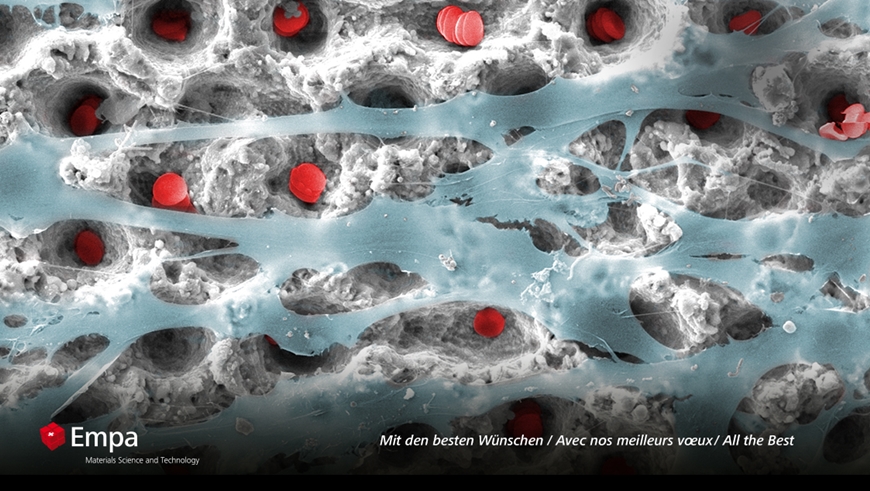Season's Greetings
Enjoy some of our festive motives throughout Empa's labs. A beautiful insight into some of our latest innovations.
Printed snowflake

This snowflake made of hydrogel was 3D printed via direct ink writing and dried to form an aerogel that can be rehydrated within five minutes without any loss of function. One possible application is wound patches that release drugs over a longer period of time. The wet-dry closed-loop design reduces transport costs, facilitates sterilization and extends the shelf life of the active ingredients.
Image: Empa
Magic crystalline structure

Perovskites possess a unique crystalline structure, which gives this material class interesting properties, particularly in its interactions with light. Like a far more powerful version of the prism on the cover of Pink Floyd’s The Dark Side of the Moon, perovskites may one day help us emit, capture and use light.
Illustration: Empa
NEST unit STEP2

A digitally manufactured staircase that winds its way up to the second floor. A wafer-thin, perforated concrete ceiling that absorbs sound. Floor and wall materials made from recycled waste. The latest unit STEP2 (front, top) in the NEST research and innovation building is a beacon for material-saving and energy-efficient construction technologies.
Image : Zooey Braun
Novel dental implants

Together with partners from industry, Empa researchers have succeeded in structuring titanium alloys for dental implants with particular precision using pulsed laser light. The flashes of laser light create a structure on which the precursors of bone cells (light blue) feel comfortable, which promotes stable ingrowth of the implant.
Image: Empa (Colored electron microscopy)
Biochar: The new concrete

The construction industry as a CO2 sink? Researchers at Empa are working on making this idea a reality. By incorporating biochar into concrete, they are exploring the potential of CO2-neutral or even CO2-negative concrete. For optimal applicability, they process biochar into pellets and use them to replace conventional aggregates.
Image: Empa
Printed solar cells from Perovskia Solar

Printed solar cells from Perovskia Solar: The spin-off's customized solar cells can be integrated into almost all electronic devices and sensors. Image: Perovskia Solar.
Image: Empa
Your branches green delight us!

The Christmas tree in this picture doesn't need any candles. It glows bright green all by itself – thanks to bioluminescence. Empa researcher Francis Schwarze has developed a process for producing bioluminescent wood using fungi. The fungal filaments of a white rot fungus penetrate the wood and feed on wood components, producing the light-generating substance luciferin. Similar to fireflies, the functionalized wood emits a greenish light in the dark thanks to the glowing fungal filaments. Glowing "snow" also piles up at the base of the tree. Here, the fungi grow in cellulose fibrils made from wood residues. So when the lights in Empa's fungal lab go out in the evening, the bioluminescent Christmas tree shines in all its glory. Image: Empa
FireDrone supports the fire department

Researchers from Empa and Imperial College London have developed a heat-resistant drone that can analyze the source of danger at close range in the event of a building or forest fire thanks to its insulating jacket made of aerogel. This allows firefighters to optimize the strategy of a high-risk operation before entering the danger zone. Image: Empa
Illuminated in the dark

Painful aesthetics: What looks like a battle star is in fact a kidney stone in a 3D visualization based on a multimodal X-ray procedure. The best way to treat kidney stones depends on how what they are composed of and how they are shaped. Empa researchers are now working on a painless diagnostic procedure using dark-field X-ray imaging. This innovative technology makes it possible to determine the structure and composition of the stones for each patient. The Maiores Foundation is funding the innovative project. Illustration: Empa
The tiniest Poinsettia flowers

These nano-sized zinc oxide flowers are a transformation product of zinc-imidazole compounds after 24 hours in ultrapure water. They are being investigated for their suitability in nanomedicine. The image was acquired using a scanning transmission electron microscope (STEM) with energy dispersive X-ray spectroscopy (EDX). Image: Empa
That's easy. Visit our Empa Quarterly Insights or subscribe (for free) to Empa Quarterly here.
-
Share






